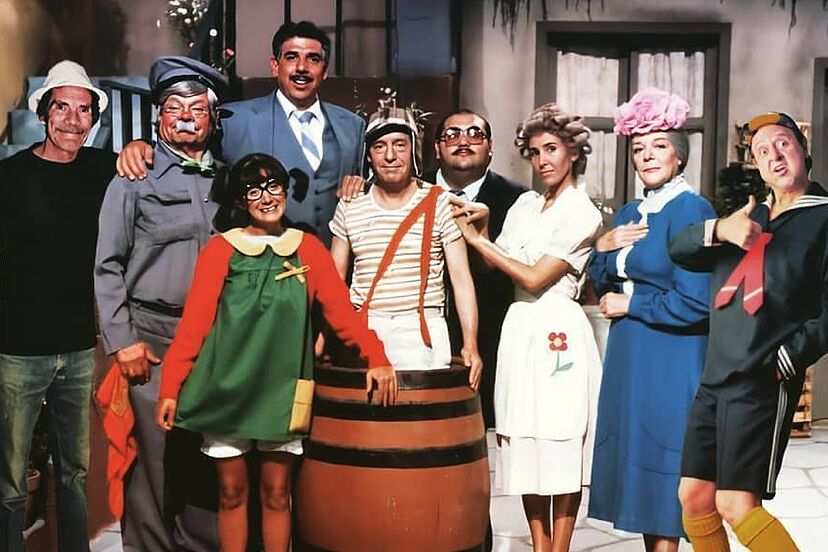Exploring the Charm of Mexican TV Shows: Your Ultimate Guide

Mexican TV shows are part of Mexican culture, not only because they are a major revenue sector, but also because many of their productions are part of Mexico’s idiosyncrasies.
Characters like El Chavo, artists of the stature of Pedro Infante, news anchors, telenovela characters, and many more are part of the daily conversation of Mexicans.
Mexican TV shows influence thinking, perception of events, and even language. Many Mexican expressions come from characters in Mexican TV shows.
This speaks volumes about the importance of television in Mexico and its influence on all aspects of daily life in the country.
Moreover, time has allowed the television industry to continue growing in Mexico, although, of course, adapting to the changes brought by technological advances and, consequently, the way TV programs are consumed.
In Recent years, electronic devices such as cell phones and tablets have been replacing TV; however, it remains a highly demanded medium.

Mexican TV Shows: History of Television
The history of television in Mexico dates back to the first half of the last century. On August 19, 1946, the first black-and-white broadcast in Mexico took place from the bathroom of the house at 74 Havre Street, in the Juárez neighborhood of Mexico City, where engineer Guillermo González Camarena lived.
The success was such that on this day, September 7, 1946, at 8:30 p.m., the first experimental television station in Latin America, XE1GC, was officially inaugurated. This highlights the importance of television in Mexico from the very beginning of Mexican TV shows.
This station broadcast an artistic and interview program every Saturday for two years, which could be considered the first TV program aired in Mexico.
Incredibly, television in Mexico had great pioneers, with technicians who enhanced the technology to greater capacities.
READ MORE: EXPLORING THE TYPES OF MEXICAN MUSIC
For instance, in the 1930s, a 15-year-old boy invented his first television camera. His name was Guillermo González Camarena.
In the 1940s, González Camarena conducted the first experimental television broadcasts from his home. He was also responsible for creating color television.
However, commercial television in Mexico was born in 1950 during the presidency of Miguel Alemán Valdés, who governed the country from 1946 to 1952.
On August 31, 1950, Channel 4 XHTV broadcast the first commercial television signal in Mexico.
A milestone in Mexican TV shows occurred in 1951. That year, Emilio Azcárraga Vidaurreta, grandfather of the current owner of Televisa, Emilio Azcárraga Jean, launched Channel 2.
Televisa is the most powerful empire in Mexican television and constitutes a significant part of the major productions in Mexico.

Telenovelas in Mexico
Televisa revolutionized Mexican TV shows by incorporating captivating stories that hooked audiences. While many productions focused on love stories, others added elements reflective of Mexican reality.
In this context, the plots by Caridad Bravo Adams became thrilling stories that kept entire families glued to their seats every night. El siguiente artículo puede darle una mejor referencia de las telenovelas mexicanas “MEXICAN TELENOVELAS”
The so-called “Mr. Telenovela” was one of the most prominent producers, and his telenovelas addressed controversial topics for society at the time, continuing to resonate today.
An example is the telenovela “El maleficio,” which dealt with themes like black magic and Satanism.
Titles such as “Gutierritos“, “Rina”, “Colorina”, “Los ricos también lloran”, “El derecho de nacer”, among many others, have remained in the memory of Mexicans.
These productions are iconic among Mexican TV shows. Many stories traveled from television to cinema and from cinema to television.
In fact, thanks to the writing of Yolanda Vargas Dulché, some stories originated in comics and had their television versions, such as “Rubí,” which has multiple adaptations, “Gabriel y Gabriela,” and the highly acclaimed “El pecado de Oyuki.”
Therefore, the telenovela industry in Mexico has not only created many stars but also provided hundreds of jobs, especially in the capital. Some telenovelas have been adapted, such as “El Vato.”
“El Vato” is a U.S. biographical television series based on the life of Mexican singer El Dasa and created by Endemol Shine North America and Boomdog Films for NBC Universo. The plot centers on the story of Mexican singer El Vato and his friends as they try to succeed in the treacherous and seductive music world of Los Angeles, California.
Mexican TV Shows: The Journey of Series
Series have always been a part of Mexican television’s growth, providing stories that are widely followed in Mexico and even throughout Latin America.
Nowadays, series have displaced telenovelas and have become the cornerstone of Mexican production.
In many cases, series have been a resounding success in partnership with streaming companies, such as Netflix.
Some examples include productions by Mexican broadcasters, such as “Por amar sin ley” and “Médicos,” which also incorporated a classic element of American television: crossovers.
With the rise of digital platforms, Mexico is now emerging as one of the major exporters of series reaching audiences worldwide.
However, today, series that depict realities related to drug trafficking and gangs in Mexico are gaining more followers. Interestingly, these shows have millions of fans not only in Mexico but around the world.
Thus, currently, Mexican TV shows have a distinctive mark: the biographies of drug lords. Netflix stories have catapulted this genre of Mexican TV shows. We can observe the journey of criminals like El Chapo, El Señor de los Cielos, and La Reina del Sur.
Undoubtedly, the story of El Chapo, which details the criminal career of Joaquín Guzmán, is one of the most representative.
This production meticulously narrates the life of this drug lord. Although it was a Univision production, this channel is currently owned by Televisa.
Many companies have moved to Mexico to produce their shows. This has been the case with the Netflix series “Narcos,” which portrays the rise of major Mexican drug lords in a highly detailed manner.
In conclusion, these stories connect with the Mexican public as they are part of popular culture; in some cases, they are seen as antiheroes.

Comedies and Dramas
Mexican TV shows have also been known for presenting humorous stories. Undoubtedly, the icon is “El Chavo del 8,” one of the most popular characters worldwide. With the main character, El Chavo del 8, they tell a story so common that it ends up being attractive to the Latin American audience.
Perhaps one of the most important aspects of El Chavo is that it reveals elements unique to the Mexican people, which have also influenced the rest of Latin America.
Meanwhile, streaming platforms are capitalizing on Mexican stories, boosting the series industry in this country.
In 2023, a Mexican comedy series, “Ojitos de Huevo,” tells us the story of a very special young boy. Accompanied by his best friend, who has cerebral palsy, a blind aspiring comedian sets out to achieve his big dream. The series has been one of the most-watched on Netflix.
The Influence of Mexican Television
By 2019, around 32.2 million households in Mexico had at least one television, representing 92.9% of the total in the country.
This is a huge figure, and while it may have varied, Mexican TV shows have transcended to other platforms.
Mexican television has managed to grow from every perspective, reaching indescribable levels of social penetration.
The fact is that the television industry has not stopped, and its reach can be global, considering the freedom through streaming and other platforms.






